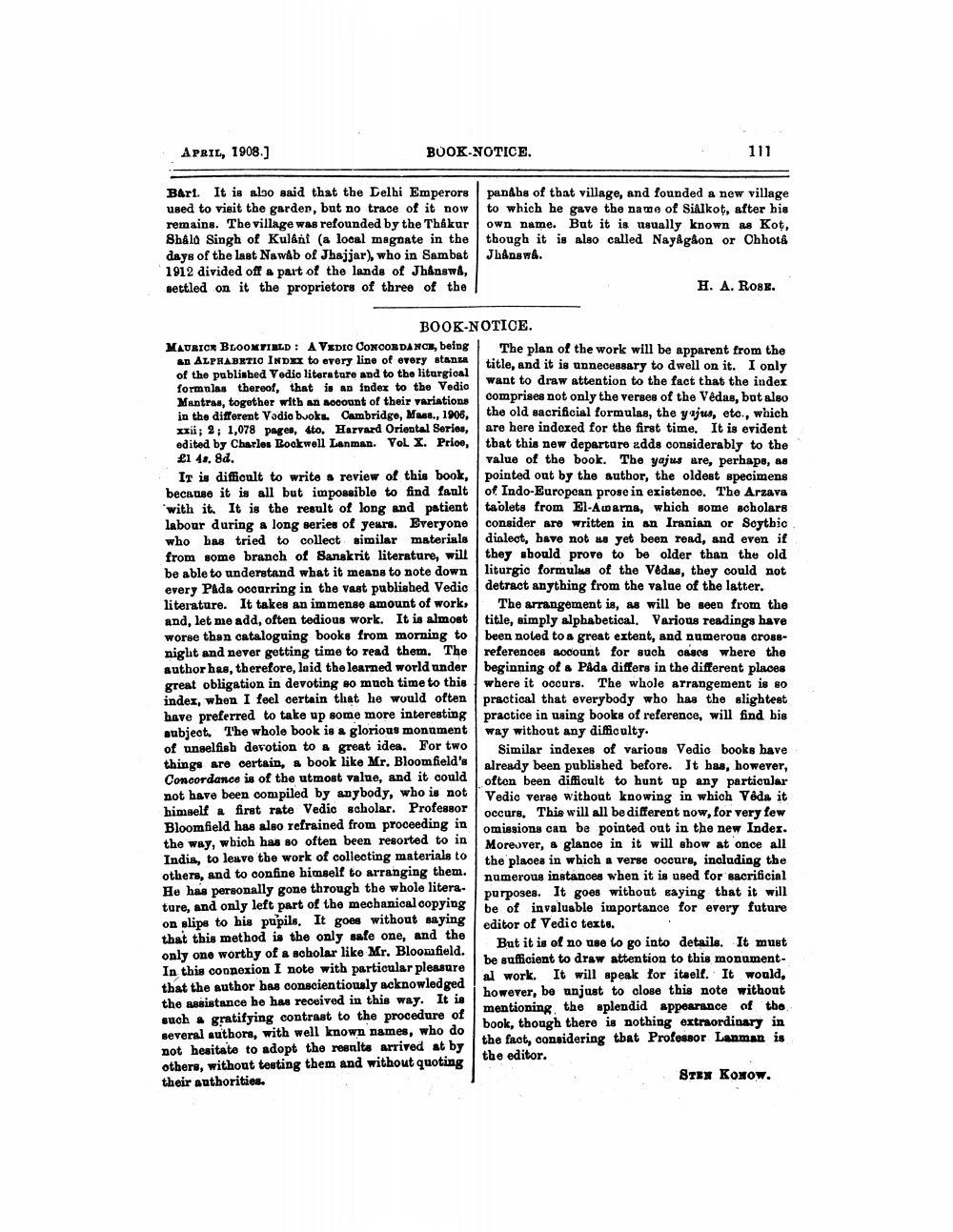________________
APRIL, 1908.]
BOOK-NOTICE.
111
Bart. It is also said that the Delhi Emperors panahs of that village, and founded a new village used to visit the garden, but no trace of it now to which he gave the name of Sialkot, after his remains. The village was refounded by the Thakur own name. But it is usually known as Kot, Shala Singh of Kulant (a local magnate in the though it is also called Nayâgaon or Ohhota days of the last Nawab of Jhajjar), who in Sambat Jhanawa. 1912 divided off a part of the lands of Jhángwa, settled on it the proprietors of three of the
H. A. Roge.
BOOK-NOTICE. MAURICR BLOOMYILD: A VEDIO CONCORDANCE, being The plan of the work will be apparent from the
an ALPHABETIO INDIX to every line of overy stanza title, and it is unnecessary to dwell on it. of the published Vedic literature and to the liturgioal
I only formulas thereof, that is an index to the Vedio
want to draw attention to the fact that the index Mantras, together with an nocount of their variations comprises not only the verses of the Vedas, but also in the different Vadio buoks. Cambridge, Mass., 1906,
the old sacrificial formulas, the y ejus, etc., which xxii; 2; 1,078 pages, 4to. Harvard Oriental Series, are here indexed for the first time. It is evident edited by Charles Rockwell Lanman. VoL X. Price, that this new departare adds considerably to the £1 43. 8d.
value of the book. The yajus are, perhaps, as It is difficult to write a review of this book, pointed out by the author, the oldest specimens because it is all but impossible to find fault of Indo-European prose in existence. The Arzava with it. It is the result of long and patient taolets from El-Awarna, which some scholars labour during a long series of yeure. Everyone consider are written in an Iranian or Scythic who has tried to collect similar materials dinleot, have not as yet been read, and even if from some branch of Sanskrit literature, will they should prove to be older than the old be able to understand what it means to note down liturgic formulus of the Vedas, they could not every Pada ooourring in the vast published Vedic detract anything from the value of the latter. literature. It takes an immense amount of work. The arrangement is, as will be seen from the and, let me add, often tedious work. It is almost title, simply alphabetical. Various readings have worse than cataloguing books from morning to been noted to a great extent, and numerous cro88night and never getting time to read them. The references account for such 08.908 where the author has, therefore, laid the learned world under beginning of & PÅda differs in the different places great obligation in devoting so much time to this where it occurs. The whole arrangement is so index, when I feel certain that he would often practical that everybody who has the slightest have preferred to take up some more interesting practice in using books of reference, will find bis aubject. The whole book is a glorious monament way without any difficulty. of unselfish devotion to a great idea. For two
Similar indexes of various Vedic books have things are certain, a book like Mr. Bloomfield's already been published before. It has, however, Concordance is of the utmost value, and it could often been difficult to hunt up any particular not have been compiled by anybody, who is not
Vedic verae without knowing in which Véda it
edir himself a first rate Vedic scholar. Professor
occurs. This will all be different now, for very few Bloomfield has also refrained from proceeding in
omissions can be pointed out in the new Inder. the way. which has so often been resorted to in Moreover. & glance in it will show at once all India, to leave the work of collecting materials to
the places in which a verse occurs, including the others, and to confine himself to arranging them.
numerous instances when it is used for sacrificial He has personally gone through the whole litera.
purposes. It goes without saying that it will ture, and only left part of the mechanical oopying
be of invaluable importance for every future on slipe to his pupils. It goes without saying
editor of Vedic texts. that this method is the only safe one, and the
But it is of no use to go into details. It must only one worthy of a scholar like Mr. Bloomfield.
be sufficient to draw attention to this monumentIn this connexion I note with particular pleasure
al work. It will speak for itself. It would, that the author has conscientiously acknowledged
however, be unjust to close this note without the assistance he has received in this way. It is
mentioning the splendid appearance of the such * gratifying contrast to the procedure of
book, though there is nothing extraordinary in several authors, with well known names, who do
the fact, considering that Professor Lanman is not hesitate to adopt the results arrived at by
the editor. others, without testing them and without quoting their authorities
Өткх Колом.




